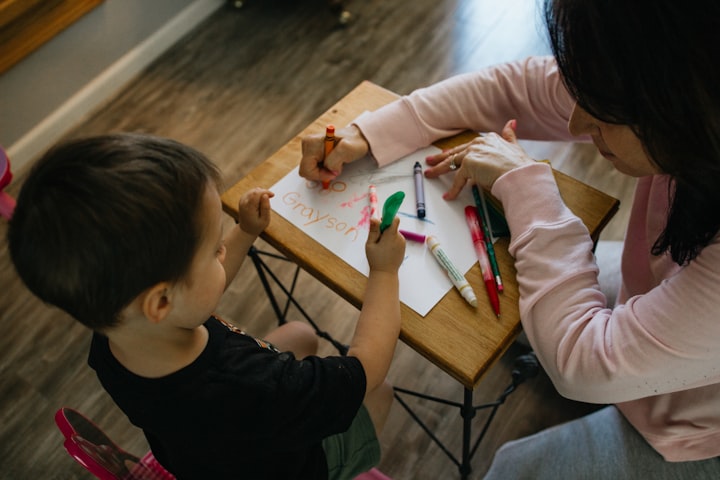I help kids with challenges gain independence and be their best selves.
Rarely do I say “I’m an ABA therapist” – I say “I work with kids on the autism spectrum providing 1:1 therapy and support.”

Reactions are mixed when I tell people what I do for a living. Often folks are curious and ask for more information. Some people are surprised – especially if we’ve met in a social situation where I’m behaving like an adult that likes to have fun. Some people reveal their discomfort or distaste for working with challenging individuals, some are impressed.
Whatever the reaction, the response I receive most often is a wide-eyed “oh boy” face, coupled with a “woo” breath, and words to the effect of “wow, I don’t know how you do it. I could never do your job.”
Yeah. It can really be a doozy.
Yes, my job can be frustrating. It can be dangerous. It can be exhausting. There are times when I want to sit on the floor and cry as much as a tantruming student. But for each maddening or mundane moment, there is a magical moment of “instant gratification.” That moment when you see the light in a child’s eyes when they finally get it. When they say or do something that we’ve been working on, or they go above and beyond the goal we set, and say something funny or brilliant.
We used to be called “Therapy Assistants,” but my license says that I am a “Certified Behavior Technician,” and we mostly say “BT” on the job and in my case notes. I provide ABA therapy after a child has had a diagnosis, an evaluation (or often several,) and a prescribed treatment plan has been approved by a Board-Certified Behavior Analyst, parents, and insurance company. Basically, when all the evaluations and discussions are over, I’m the person that comes every day (or a couple of times a week,) to do the work directly with the kid. I work in homes, with families. I work in schools, with teachers and support staff. I work in communities, helping youth learn how to navigate the world around them. My clients have ranged in age from 20 months to 16 years old.
What is ABA? Well, it stands for “Applied Behavior Analysis” and it’s an evolving, data-driven, child-centered science. That sounded very officious and stodgy, so let me break it down – because that’s what I do. The word “applied” is most important here. APPLIED means that we apply our skills and knowledge to an individual, and try to help them accomplish certain goals. Every kid is different, so one may be working on learning to talk, while another may be learning what idioms are, and how to use them in social conversation. Yet another kid may be learning how to determine the size of a problem, and how to match their reaction appropriately. I often find myself saying “I think that you are having an eight reaction to a two problem” when one of my students is having a meltdown over a seemingly minor issue.
We work on IDing body parts, learning when to keep them covered, how to listen to our bodies, and how, when, and where to go potty. Learning to wash hands correctly is another popular task that I work on with my clientele, especially now during COVID. Some of my kiddos have sensory issues that make what seem like “basic” tasks challenging. To continue with the hand washing example, if a child hates getting wet, they may avoid washing. I might teach them a simple modification in their handwashing chain: first, push up your sleeves. Then I may teach them how to keep a “calm body” if their shirt does get wet, and how to “use their words” to ask to go get a dry shirt from their cubby or backpack. These seemingly minor accommodations can save hours (or years) of heartache, tantruming, and stress. If a kid is obsessing over a damp sleeve, they are likely not able to concentrate on anything else in school.
I often say that my job providing early intervention therapy is like teaching a foreign language to children who have never experienced another culture. Reaching them early, and on their level, can help provide for their success. I prefer early intervention - children that are preschool age or younger. Keeping it fun and engaging is a must! Older kids present their own challenges, but I also enjoy the early teen years of self-discovery. Helping tweens navigate the minefield of academics and socialization is both challenging and extremely rewarding. Sometimes my students need an advocate as well as a support person. Often a teen just needs someone to be honest without shaming them.
A humorous example: several years ago I was picking a student up from school. I had to go inside and get them from the specialist's office. It was a cold, rainy, fall day, and when I walked in, I was apparently "nipping" through my light sweater. My client greeted me, then pointed at my nipple and said "what's that?" The school specialist was clearly uncomfortable and immediately reacted to the child's question by saying "oh come now! You know what that is! We don't talk about that! That's not nice!" Whereas, I turned to the child (who was about 10 years old at the time and also had nipples,) and said "that is my nipple. Sometimes when it's cold, our nipples will poke out like that." The kid said "oh" and moved on with their life. My point being - who do you think taught this child about nipples, and why shame them for asking honest questions? Particularly individuals with social and language delays - they may not pick up on other cues, or a verbal lesson in health class. We have to be patient, flexible, and direct. Kids with autism don't often get subtle hints.
Occasionally I encounter someone that opposes ABA therapy because they believe that it tries to “conform” children to neurotypical standards, and fails to recognize the unique culture and needs of neurodiverse populations. I understand this, and I think that ABA is evolving to be more inclusive, more sensitive, and more child-centered than it used to be. I don’t want to force a kid to do drills or to change who they are. But I do want to help a kid understand that it’s not safe to run into the street, that we wait to get into the potty to pull down our pants, that "raining cats and dogs" doesn't involve animals, and other basic life skills that will help them stay safe.
I help make the world a better place by helping neurodiverse children find their voices, gain independence, and be the best that they can be!
About the Creator
Allison Rice
Finalist 2022 V+ Fiction Awards, Allison Rice is a work in progress! Author of 5 previous Top Story honors including “Immigrants Among Us” "Pandemic ABCs" and a piece about Inclusion, Alli is an avid reader, and always has a story to tell!






Comments
There are no comments for this story
Be the first to respond and start the conversation.